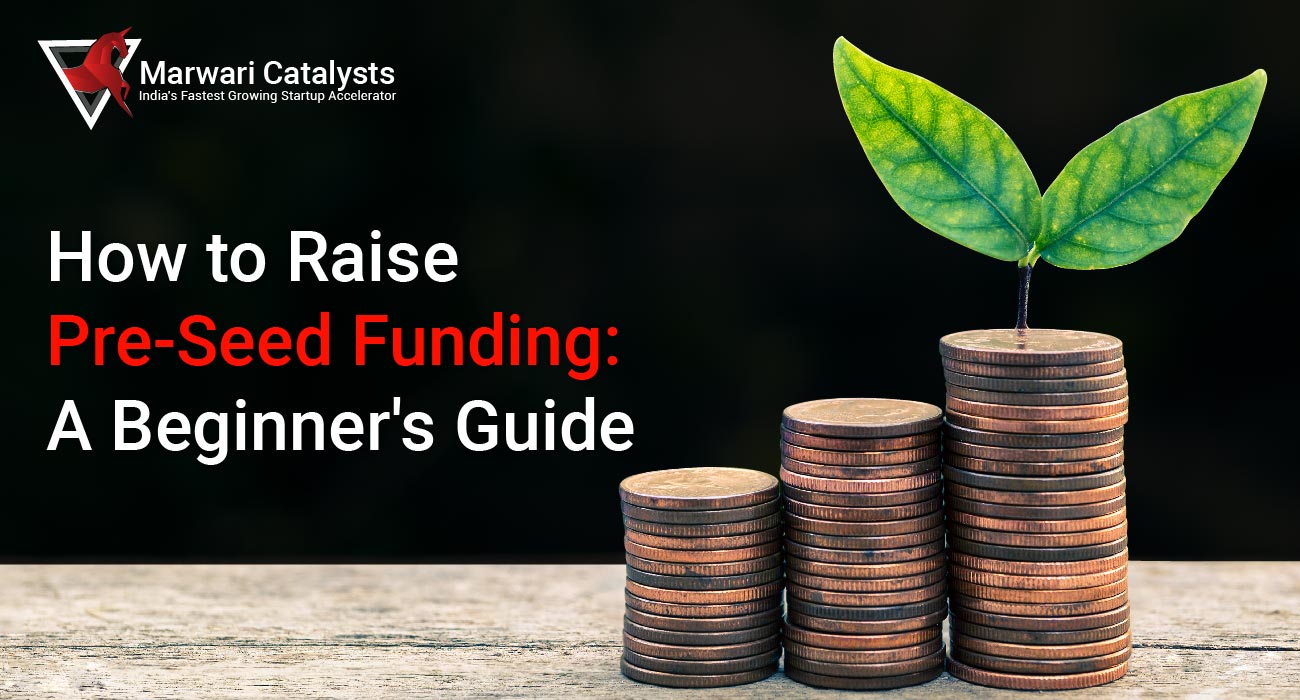How to Raise Pre-Seed Funding: A Beginner's Guide

Establishing a company is filled with plenty of emotions, including excitement, motivation, and challenges; at times, it can be a daunting experience too.
One such experience that can be overwhelming for every startup founder is raising capital for the first time.
"How much capital is required? Where to start? How to find potential investors?" are the types of questions that spring to the mind of every startup founder. And wait, the primary question is, what is pre-seed funding? Types of pre-seed funding and how does it work?
In this article, we're going to address the exact same questions. So, read further.
What is Pre-seed Funding?
Pre-seed funding is often the first stage of funding, right before the seed funding and other stages. During this stage, investors provide startups with capital to get their businesses off the ground and start developing products which can be used to raise further funding.
The Difference Between Pre-seed and Seed Funding Round
The definitions of the pre-seed and seed fund slightly overlap, but the key differences are:
- Seed funding is widely considered the first 'official' funding round, and it involves more formal investing and provides instrumental growth after the pre-seed funding stage.
- Founders tend to receive higher investments from seed funding than from pre-seed.
- During the seed funding round, investors look for a company who has gained a degree of traction, but the pre-seed round precedes the product development phase.
Types of Pre-seed Funding
The pre-seed funding can originate from a range of sources, but the first step to raising pre-seed funds is bootstrapping. In case startup founders are unable to cover the operating costs, they go for external sources.
Let’s look at the most popular options for securing the first round of capital:
Friends & Family
Friends and family are the most common and popular pre-seed funding options for startups. Founders often invest their personal wealth or seek help from friends and family to start their businesses.
Incubators
Incubators provide capital and also help startups fine-tune their business ideas. Moreover, they offer services, including assistance, office spaces, and networking opportunities.
Accelerators
Accelerators focus on fast-scaling business ideas that have high-growth potential. They help early growth stage startups by providing finance and education. Primarily, their focus is on growing startups, but some accelerators also offer pre-seed capital.
Crowdfunding
Crowdfunding is a method of raising money in small donations from a large number of people online. Here, the firm has access to a large investor base and is exposed to thousands of people’s inspections, who can help identify shortcomings in the product. This is a great method, but it relies on how heavily you market your brand to stimulate interest.
Angel Investors
Pre-seed angel investors are wealthy individuals who invest their own money in exchange for equity in startup businesses. They look for big risks and invest in small amounts ranging from $25-100k in startups during their pre-seed phase.
Venture Capitalists
Venture capitalists provide funding to startups in the later stages of funding rounds. But, certain venture capitalists specialize in funding startups at the pre-seed stage. They are also the pickiest investors, and the success rates are low.
How to Get Pre-seed Funding in India?
Securing pre-seed funding from the top investors in India for startups can be daunting. But if you work harder and have high confidence in the brand you wish to build, it will not be a challenge to convince the investors.
Let's go through the major steps you need to focus on when approaching pre-seed investors.
Step 1: Create Your Pitch Deck
You need a great pitch deck to secure pre-seed funding. Pitch decks disclose all the crucial information to the investors about the startup, product, market, financial projections, and short-term and long-term plans.
Investors will get to learn about the brand better and the issue it addresses, so the pitch deck should include all the components mentioned below. But note simplicity and brevity is the key.
- How is your brand unique?
- Explain your business model.
- The market demographics you are targeting.
- Explain your revenue model.
- How are you planning to engage your customers?
- Explain where your brand stands 10 years from now.
- The capital you are planning to raise, and how would you utilize it?
Addressing these questions in the pitch deck will make investors clear about your brand and future plans, and they can decide if they want to invest or not.
Step 2: Make An Investor List
Not every investor you are looking for will provide pre-seed funding for startups. Utilize your professional network to find investors interested in startups at this stage. Investigate potential investors using these key traits:
- Type: What type of investors are you looking for? Some startups are looking for capital, while others want expertise in their field and business connections.
- Funding: Choose the investors whose investment matches the amount of funding to your needs.
- Expertise: What level of knowledge the investor possesses in your industry? If they can understand your business and play an active role in scaling and growing it.
- Experience: Look for investors who have prior experience in working with pre-seed firms. Pre-seed experience is quite different from post-seed funding experience.
- Integration: Check out investors’ past track records and see how they have impacted other pre-seed startups. Your working relationship with an investor will influence your partnership’s overall outcome.
What matters the most is that the investor possesses experience and knowledge in dealing with pre-seed companies in particular. Look beyond the funding alone and see what they have done for the other startups in their journey.
Step 3: Present to the Investors
Before investing in your company, most startup investors will conduct a meeting and require an in-person presentation to know you and your brand better. It is certainly the most nerve-wracking step in the process, but you need to showcase your true and best self during the presentation.
Startup success hinges on the founder, so they must project both confidence and humility. In contrast, overconfidence and arrogance should be forfeited during the presentation with the pre-seed investors. Some tips for nailing your presentation:
- Keep your presentation simple.
- Know who your investor is.
- Be realistic.
- Interact genuinely.
- Showcase your ambition.
- Show off your charm and demonstrate your passion.
Make sure you practice the pitch before the actual presentation. You should know your pitch by heart before meeting the investors in person.
Wrapping Up
Raising pre-seed funding can be a nuanced process, but it is one of the important stages. You'll likely meet several investors in your journey, but since you only have a minimal viable product and no market experience as of yet, you might get turned down before achieving success.
The hard truth is you will need to work harder to find investors initially who are willing to commit to your startup at an early stage but trust us, it will be worth the wait in the end.
If you're willing to explore investment opportunities for your early growth-stage startups, look nowhere else, as Marwari Catalysts is here to guide you at every step.
Also Read : How Marwari Catalysts is a bridge between startups and investors??
FAQS
1. What is Pre-seed Funding?
Pre-seed funding is the initial capital raised by startups to develop their idea or product, often used for market research and early product development.
2. How is Pre-seed Funding Different from Seed Funding?
Pre-seed funding is typically smaller in amount, focusing on idea development, while seed funding is larger, aimed at early-stage business operations.
3. What are Common Sources of Pre-seed Funding?
Sources include friends and family, incubators, accelerators, crowd funding platforms, and angel investors.
4. How Can a Startup Create an Effective Pitch Deck for Pre-seed Funding?
A pitch deck should be clear, concise, and compelling, highlighting the business idea, market potential, and the team's capabilities.
5. What Should Startups Consider When Making an Investor List?
Consider investors' interest in the industry, investment history, and potential value-add beyond capital.
6. How Should Startups Present to Investors for Pre-seed Funding?
Presentations should be passionate, realistic, and straightforward, focusing on the business model and growth potential.
7. What are Some Challenges in Raising Pre-seed Funding?
Challenges include establishing credibility, articulating a clear business vision, and finding the right investors.
